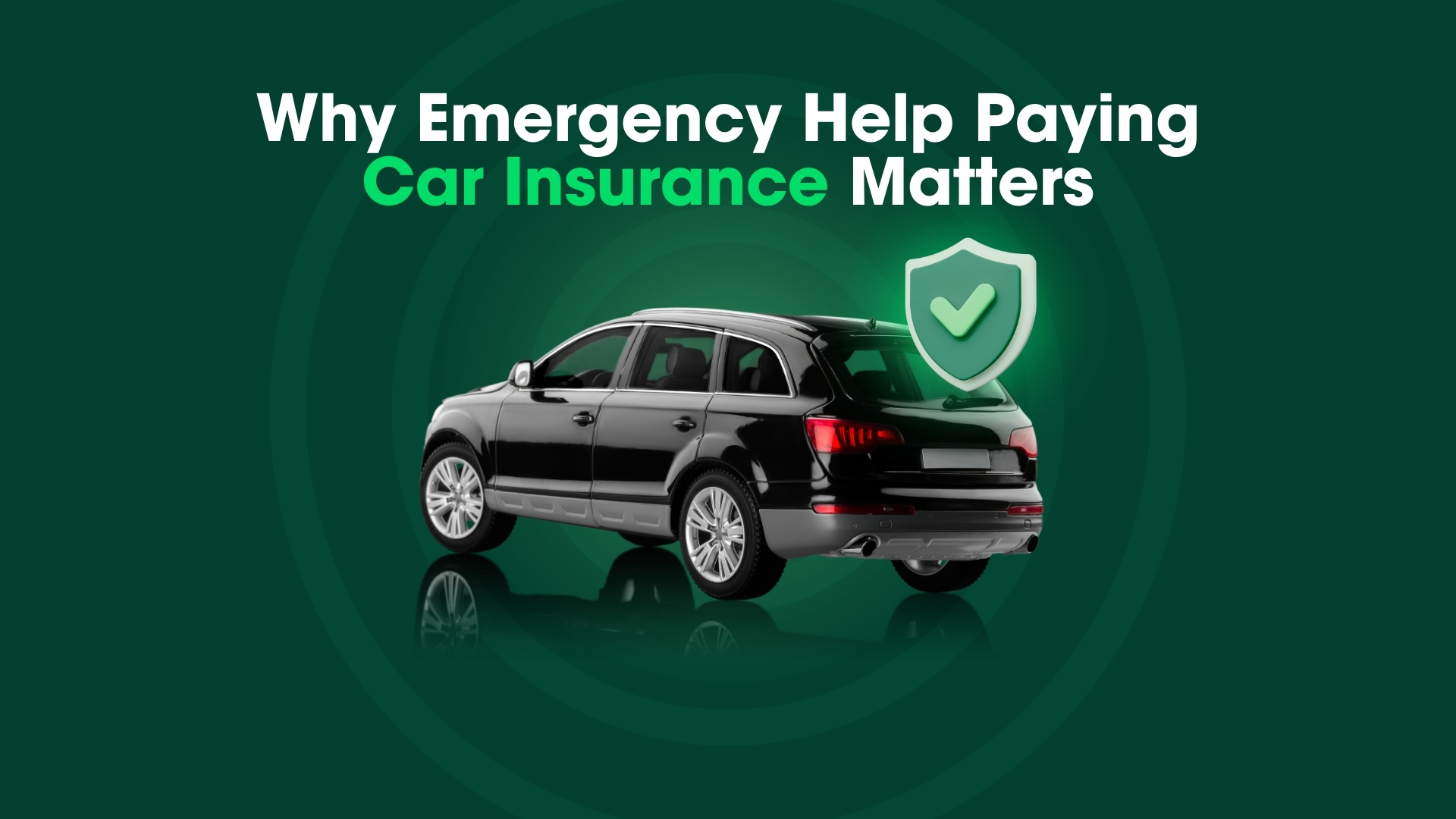Your car insurance is due, and there’s just no room in the budget. If you’re scrambling for emergency help paying car insurance, you’re not alone and you’re not out of options. Millions face this same stress, worried about losing coverage they can’t afford to replace. This guide walks you through proven programs, urgent relief options, and even EBT car insurance discounts to help you stay insured without falling further behind.
Key Takeaways
- Act fast to avoid a coverage lapse your provider may offer flexible options like grace periods or payment plans.
- Low-income drivers may qualify for state or nonprofit assistance to reduce or cover car insurance costs.
- If you receive EBT, you might be eligible for special insurance discounts check with your insurer.
- Explore local aid, temporary insurance options, or usage-based plans to stay covered on a tight budget.
- Don’t wait affordable help is out there. Staying insured protects your finances and keeps you legal.
Table of Contents
Why Emergency Help Paying Car Insurance Matters
Staying insured isn’t just a formality it’s protection for your wallet, your license, and your peace of mind. When you’re dealing with a tight budget, car insurance might feel like a low priority. But letting it lapse can create bigger problems fast. Emergency help is there for a reason: to keep you from losing your coverage when you need it most.
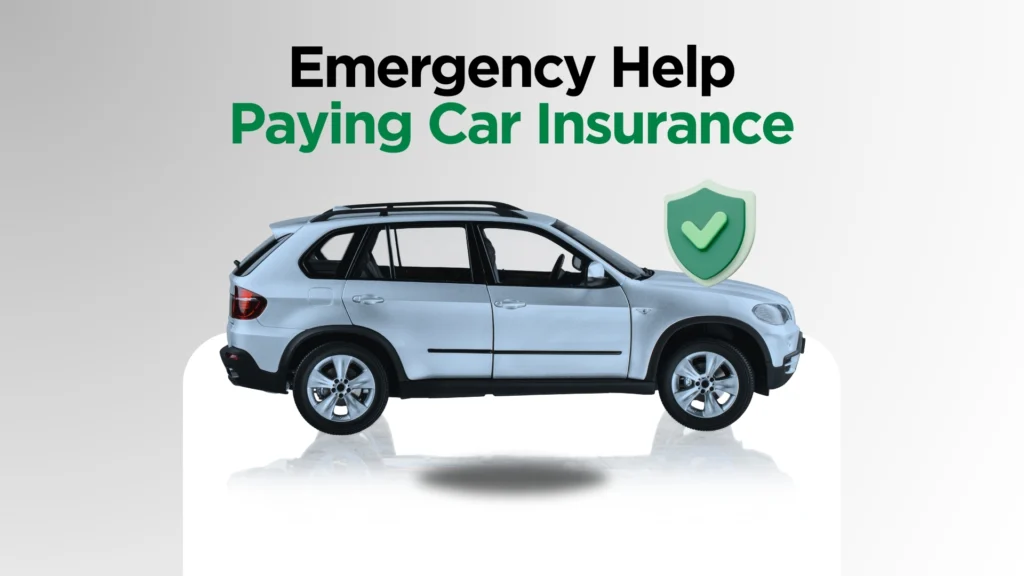
The Risk of Insurance Lapse During Financial Hardship
Missing a car insurance payment doesn’t just pause your coverage it can cancel it altogether. Once your policy lapses, even by a few days, insurers may flag you as high-risk. That means higher rates when you try to restart your plan or worse, getting denied coverage altogether.
Here’s what can happen after a lapse:
- Your insurer cancels your policy
- You lose access to claims coverage
- You pay more for insurance in the future
- You risk driving illegally
If you’re struggling to pay, don’t wait. Ask for help. Many providers offer grace periods, payment plans, or adjustments if you contact them early.
💡 Tip: A lapse of just one week can raise your premiums by 8–15%. Staying covered is often cheaper than restarting later.
Legal and Financial Consequences of Driving Uninsured
Driving without insurance is more than risky it’s illegal in most states. If you’re caught, the penalties can be steep:
- Fines (often $500–$1,000 or more)
- Points on your license
- Vehicle impoundment
- Even jail time in some states
And if you get into an accident without coverage? You’ll be on the hook for all damages yours and the other driver’s. One emergency room visit or car repair could cost thousands out of pocket.
First Steps When You Can’t Afford Car Insurance
If you’re facing a tight budget and unsure how to keep your coverage, don’t panic. There are quick, smart steps you can take to avoid losing your car insurance. The sooner you act, the better your chances of finding help paying car insurance without a gap in coverage.

Contact Your Insurance Provider About Temporary Relief
Start by calling your insurance company. Many providers offer emergency relief options when you’re struggling to pay. These may include short-term extensions, one-time deferrals, or special hardship accommodations. But you need to ask insurers won’t offer these options automatically.
Let them know you’re looking for temporary help paying auto insurance due to a financial emergency. Be honest and clear. It’s in their interest to keep you covered, not to cancel your policy.
Ask About Grace Periods, Payment Plans, or Policy Adjustments
Most car insurance providers offer a grace period a few extra days after your due date to make a payment without cancellation. It’s not guaranteed, but it’s worth asking about. Even a 7-day grace period can give you time to pull things together.
You can also ask about payment plans that break your premium into smaller amounts, or policy adjustments that lower your rate. This could mean raising your deductible, dropping optional coverages, or re-evaluating mileage.
Questions to ask your provider:
- “Do you offer a payment plan option?”
- “Is there a grace period for late payments?”
- “Can I adjust my policy to make it more affordable right now?”
These small changes can help you stay insured until your finances stabilize without giving up the protection you need.
Government and Nonprofit Programs That Help Pay Car Insurance
If you’re struggling to stay insured, you’re not alone and you’re not without options. Several government programs and nonprofit services offer emergency help paying car insurance, especially if you’re low-income, on EBT, or facing unexpected hardship. These aren’t just tips they’re real programs that have helped people keep their coverage.
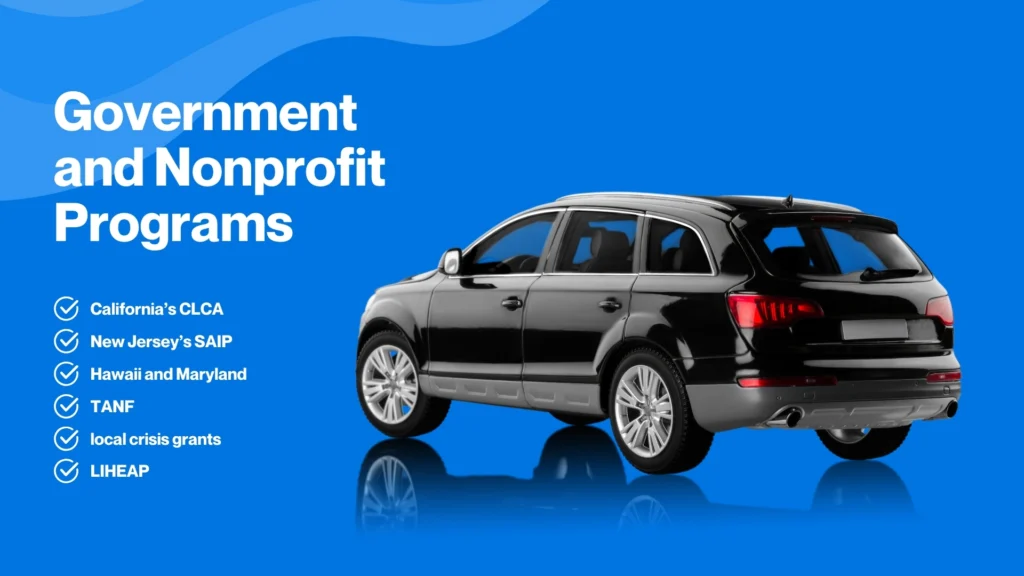
State-Run Low-Income Car Insurance Programs
Some states offer special car insurance plans for low-income drivers. These programs provide basic coverage at much lower rates, often based on income, vehicle value, or driving history.
Examples include:
- California’s CLCA (California Low Cost Auto Insurance) – Open to income-eligible residents with clean records.
- New Jersey’s SAIP (Special Auto Insurance Policy) – Offers emergency medical-only coverage for drivers on Medicaid.
- Hawaii and Maryland also have reduced-cost programs with specific guidelines.
If you’re looking for help paying auto insurance and live in one of these states, you could qualify for discounted plans that meet state minimums. It’s worth checking your state’s Department of Insurance website to see what’s available.
Federal or State Emergency Assistance Funds
While there’s no federal program just for car insurance, many emergency assistance programs can help cover it as part of essential expenses. These include:
- TANF (Temporary Assistance for Needy Families): Some states allow TANF funds to be used toward auto-related costs.
- LIHEAP or local crisis grants: While focused on energy bills, these programs often refer applicants to broader financial help.
Eligibility usually depends on income, family size, and need. Reach out to your local social services department or benefits office for guidance.
Community Action Agencies and Nonprofits Offering Car Insurance Help
Don’t overlook local help. Community Action Agencies (CAAs) exist in nearly every U.S. county. They specialize in crisis relief often including help paying car insurance or other urgent bills.
Other places to check:
- Catholic Charities
- Salvation Army
- 211.org (United Way Hotline) – A quick way to find emergency help near you
These nonprofits may offer one-time grants, gas vouchers, or referral programs that help you stay insured and on the road. Some even partner with insurance providers to offer discounts to low-income drivers, including those using EBT.
EBT Car Insurance Discounts and Eligibility
If you have an EBT card, you’re probably looking for ways to save on every bill including car insurance. While EBT itself doesn’t pay your premium, it can qualify you for special low-income car insurance programs in some states. These programs help reduce monthly costs so you can stay insured, even when money’s tight.
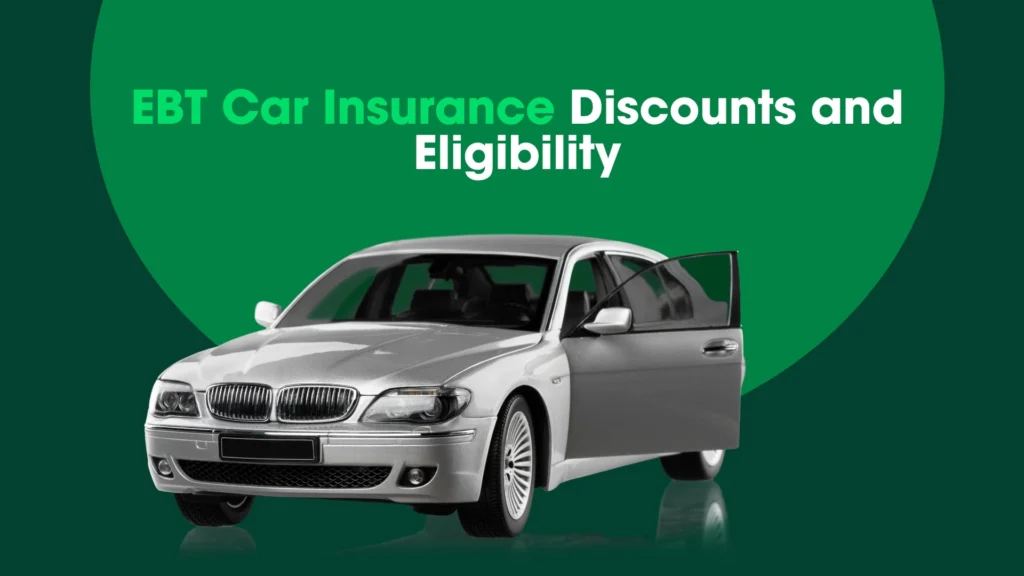
Can You Get a Car Insurance Discount with EBT?
Yes but not directly. EBT is a form of proof that you receive government assistance, which some insurers or state programs use to determine if you qualify for reduced-cost insurance.
You’re not getting a “discount” because of EBT itself, but you may get:
- Access to state-subsidized insurance programs
- Eligibility for low-income driver rates
- Help from nonprofit programs that assist those receiving SNAP
So if you’re searching for an EBT car insurance discount, what you’re really looking for is insurance help based on income and EBT is one way to show that you qualify.
States or Providers That Recognize EBT Eligibility
Some states have auto insurance options specifically for low-income drivers. Having EBT or SNAP benefits can help you qualify:
| State | Program Name | EBT Accepted as Proof? |
| California | CLCA (Low Cost Auto Insurance) | Yes |
| New Jersey | SAIP (Special Auto Insurance Policy) | Yes (must have Medicaid) |
| Hawaii, Maryland | Various income-based programs | Possibly (check guidelines) |
Outside of these programs, a few insurance companies may offer hardship assistance or refer you to outside help if you’re receiving public benefits like SNAP or TANF. Always ask your insurer if they have a low-income discount or financial hardship policy many don’t advertise it.
How to Apply or Verify Your EBT Status with Insurers
Applying for help using your EBT status is usually simple. Here’s how:
- Contact your state’s low-income insurance program (like CLCA or SAIP).
- Visit their website or call directly.
- Have your EBT card or award letter ready.
- Talk to your current insurer.
- Ask if they offer payment plans or reduced rates for low-income drivers.
- Mention you receive SNAP or EBT some may refer you to partner programs.
- Use local nonprofits or 211.org.
- They can help you find car insurance resources that recognize your EBT eligibility.
Other Ways to Get Help Paying Auto Insurance Quickly
Not every solution comes from a government office or major insurer. If you’re facing a real-time crisis, here are other fast ways to find help paying car insurance and stay covered.
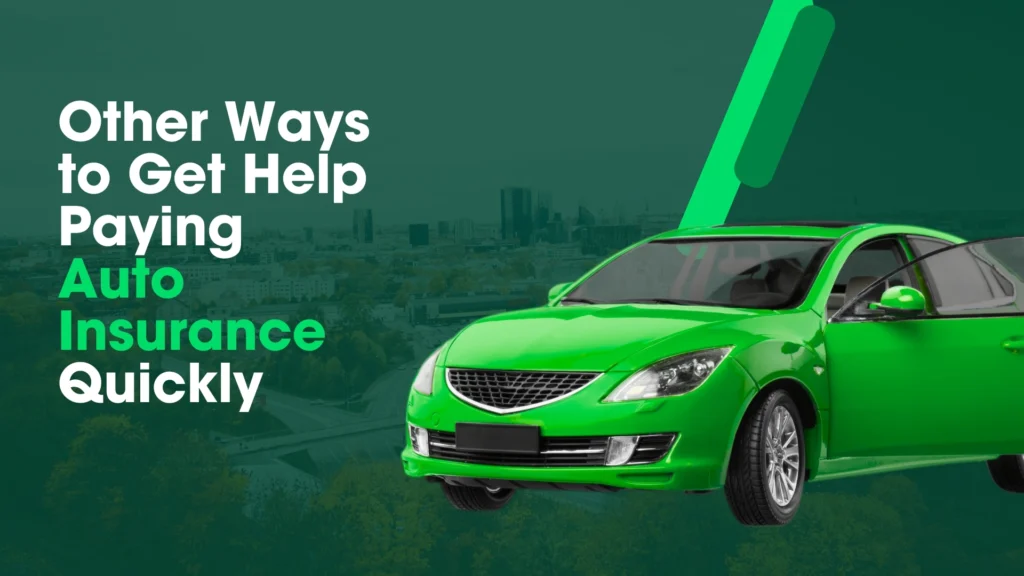
Local Charities or Religious Groups Offering Emergency Funds
When you’re short on time and money, a nearby charity or faith-based group may step in. These organizations often provide small grants or one-time payments for urgent bills like car insurance especially if it affects your job, health, or safety.
Where to start:
- Dial 211 or visit 211.org to find local emergency help.
- Check Salvation Army, Catholic Charities, or United Way branches in your area.
- Ask local churches or community centers many help members and non-members alike.
Crowdfunding and Peer-to-Peer Help Platforms
You don’t need a huge audience to get help online. Platforms like GoFundMe, Modest Needs, or Facebook groups allow people to raise money fast for things like car repairs or overdue insurance premiums.
Some ideas:
- Tell your story honestly and clearly. People want to help when they understand the need.
- Use photos, bills, or even a short video to explain what you’re facing.
- Share your fundraiser with family, friends, and online communities especially local or Mutual Aid groups.
Switching to a Cheaper Car Insurance Plan Temporarily
If help isn’t coming fast enough, lowering your insurance cost even temporarily might buy you time.
Here’s how:
- Downsize coverage to your state’s minimum legal requirement (just make sure you stay compliant).
- Ask about usage-based or pay-per-mile policies if you drive less.
- Shop for quotes from budget-friendly insurers like GEICO, Progressive, or local co-ops.
Some plans also offer “pause” options like delaying non-essential parts of your coverage or setting up flexible payments.
How to Stay Insured Without Breaking Your Budget
Keeping car insurance active doesn’t have to wreck your finances. If you’re struggling with high costs, here are smart ways to save without risking a lapse in coverage.
Reduce Coverage (If Safe and Legal)
One fast way to lower your premium is to scale back your coverage.
If your car is paid off and isn’t worth much, you might not need comprehensive or collision insurance. Instead, you can switch to liability-only, which meets legal requirements and covers damage to others but not your own car.
Shop for New Quotes Even If Mid-Policy
You don’t have to wait until renewal to find a better deal. Many drivers save money by switching insurers partway through their policy.
- Compare quotes from multiple companies online.
- Look for discounts tied to safe driving, low mileage, or prior coverage.
- Some insurers waive cancellation fees but check your current policy to be sure.
💡 Tip: Budget-focused insurers like GEICO, Progressive, and State Farm often offer flexible plans for people who need help paying car insurance.
Use Pay-Per-Mile or Usage-Based Insurance
If you don’t drive much, you could save a lot with pay-per-mile insurance. These plans track how far you drive and charge you based on actual usage perfect for remote workers, seniors, or anyone with a short commute.
Top providers include:
| Company | Type of Plan | Notable Feature |
| Metromile | Pay-per-mile | Rates based on actual mileage |
| Root | Usage-based | Premium adjusts with driving habits |
| Mile Auto | Pay-per-mile (no device) | Uses phone photos of odometer |
📱 Most plans use an app or plug-in device to track mileage or driving behavior. You could cut your premium by 30% or more.
Conclusion
If you’re struggling to afford car insurance, you’re not alone and you’re not out of options. From state-run programs to EBT discounts and nonprofit support, real help is out there to keep you covered when it matters most. Don’t wait until your coverage lapses. Reach out to your insurer, explore local resources, and apply for programs that match your situation. Taking action today can protect your car, your finances, and your peace of mind. Stay empowered there’s support available, and you deserve to drive with confidence.
FAQs
What can I do if I suddenly can’t afford my car insurance?
Contact your insurance provider right away. Many offer grace periods, payment plans, or policy adjustments during emergencies. Acting fast can help you stay covered.
Are there government programs that help pay for car insurance?
Yes, several states offer low-income car insurance programs. You may also qualify for emergency assistance funds or nonprofit aid, depending on your income and location.
Can I get a car insurance discount if I have EBT?
Possibly. Some insurers offer discounts if you receive SNAP or other benefits. Ask your provider directly if they recognize EBT eligibility.
What happens if I let my car insurance lapse?
You could face fines, license suspension, and higher future premiums. In some states, it’s also illegal to drive without insurance.
How do I find out if my state offers low-income car insurance programs?
Check your state’s Department of Insurance website or call them. Programs vary by state, and some have very specific eligibility rules.
Can charities or local organizations help with emergency car insurance costs?
Yes. Community action agencies, churches, and local nonprofits sometimes offer short-term help. Call 211 to find services in your area.
What’s the fastest way to lower my car insurance right now?
Switch to a cheaper policy, reduce your coverage safely, or ask about usage-based plans. Some changes can take effect immediately.

